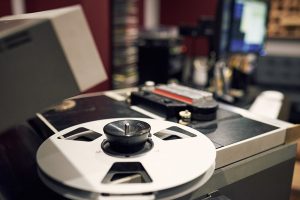 The art of audio mastering is just that: an art. Whether the final delivery format is CD, vinyl, digital download, streaming or Dolby Atmos, mastering is the last technical and artistic step in the production process.
The art of audio mastering is just that: an art. Whether the final delivery format is CD, vinyl, digital download, streaming or Dolby Atmos, mastering is the last technical and artistic step in the production process.
While it’s true that great equipment is very important in realizing a project’s full potential, it’s only useful in the hands of an experienced engineer, equipped with the critical listening skills to help create a master that realizes your true creative vision.
We bring professional, unbiased ears, and a fresh, invaluable third-party perspective to each and every project. Our goal is to help our clients end up with the best sounding projects possible, giving your upcoming release a far better chance at being successful.
We encourage clients to attend sessions when they can; that’s one reason we built such a comfortable room here in Westchester, NY. Hearing your masters play on our full-range reference monitors in our calibrated listening environment may be the best listening experience you’ll have.
Our staff is dedicated to helping all clients, big and small, and will treat them with equal care, focus, and relentless commitment to the craft. We look forward to working together on your upcoming release.
Equipment List
Hardware
MASELEC MTC-1X Stereo Mastering Transfer Console
MASELEC MLA-4 Stereo Triband Compressor / Expander
MASELEC 2012 HF & Peak Limiter (DE-ESSER)
PRISM MLA-2 Mastering Stereo Compressor
MANLEY Massive Passive Stereo Mastering EQ
MANLEY Variable MU Stereo Limiter / Compressor – Mastering Version
WEISS EQ1 Mastering EQ
SONTEC MES 431C Parametric Mastering Equalizer
BUZZ AUDIO REQ 2.2 Equalizer
ANAMOD ATS-1 Analog Tape Simulator
MERGING HAPI MkII Interface
PENDULUM AUDIO Analog Peak Limiter
WAVES L2 Ultramaximizer
APOGEE Symphony I/O MkII Audio Interface
Z-Sys 16×16 Digital Router
SPL Phonitor SE Headphone Amplifier
Lavry M-AD 824 A/D Converters
Lavry M-DA 824 D/A Converters
Sonic Solutions D/A
Lucid GENx696 Clock Generator
Monitoring
KEF 207.2 Reference Monitors (Full Range)
McIntosh 2100 Amplifiers
Taytrix Custom Sound Panel Construction and Bass Diffusor
RealTraps Mondo Traps
B&B Systems AM-2B Phase Scope & VU Meter
Mytek DDD-603 Digital Level Meter (AES)
Mytek Stereo 192 DSD DAC
Players / Recorders
NAKAMICHI BX-100 2 Head Cassette Deck
Ampex ATR-102 1/2” and 1/4” (ANALOG TAPE MACHINE)
Sony CDP-D500 CD Player/Recorder
Tascam DA-45 HR 24 Bit DAT Recorder
Tascam 122 mkIII Cassette Player/Recorder
Technics SL1200 MD3 Direct Drive Turntable
HHB CDR830 CD Player/Recorder (w/ CD-TEXT)
Dell USB Slim DVD +/- RW Drive – DW316 (CD Burner)
Apple DVD USB SuperDrive (CD Burner)
Software
Pyramix Premium DAW
DiscWrite – DDP, Track List, and PQ Log Creation Software
Pro Tools Ultimate
SoundBlade HD DAW
CEDAR for Pyramix 64 – Audio Clean up (Auto Declick, Manual Declick, Auto Decrackle, Auto Dehiss, Dethump, & Retouch 7)
WAVES Horizon Plugin Bundle
DMG Limitless
METRIC HALO Sontec MES-432-D9D EQ Plugin
DOLBY Atmos Renderer
No-Noise II (Full) Premier noise, de-click, de-hum, and de-crackle algorithms.
Sonic EQ 4-Band Equalizer
Izotope VIVE Restoration Suite
Spectre Real-Time Signal Analyzer
Studio Configured With:
Middle Atlantic Products, Ltd. PD-915R’s
 We offer full audio clean-up and restoration using the latest, most effective noise suppression and restoration software from CEDAR Audio along with our Pyramix DAWs. Complete with the full de-click, de-crackle and no-noise package, it’s simply the best set of tools we’ve ever heard for the removal of broadband noise, digital clicks and pops, vinyl surface noise, impulse & hum, buzz, acoustic interference, overload and distortion. We also provide Audio Restoration Services for legal, investigative and other personal applications.
We offer full audio clean-up and restoration using the latest, most effective noise suppression and restoration software from CEDAR Audio along with our Pyramix DAWs. Complete with the full de-click, de-crackle and no-noise package, it’s simply the best set of tools we’ve ever heard for the removal of broadband noise, digital clicks and pops, vinyl surface noise, impulse & hum, buzz, acoustic interference, overload and distortion. We also provide Audio Restoration Services for legal, investigative and other personal applications.